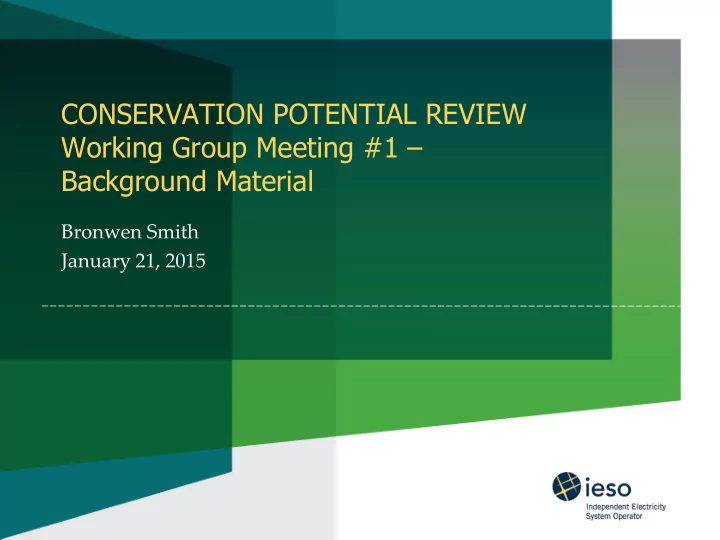

CONSERVATION POTENTIAL REVIEW Working Group Meeting #1 – Background Material Bronwen Smith January 21, 2015
Purpose and Outline Purpose: • provide WG with an overview of the background work/research IESO staff have done related to the next conservation potential review Outline: • Previous study – lessons learned • Research review / jurisdictional scan • Scoping workshop results • Work that will inform the study (product standards, new and emerging techs, BMG study) 2
Work to date • Review of previous achievable conservation potential studies • Research review - jurisdictional scan and best practices • Engage key stakeholders – Scoping Workshop • Draft project guideline document – project overview and scope – governance structure – project work plan 3
Previous studies ICF 2005 • Predominantly based on savings achieved in other jurisdictions • Disaggregated into sectors end-uses measures – Using data from other jurisdictions, other sources MKJA 2006 • Similar approach as 2014 Marbek study • MKJA used end-use level model • Took national study on gas + electricity broke out for ON and just electricity • Lower AP considers only information measures ICF Marbek Study 2014 • Used EUF – developed modified TP, EP • Two AP scenarios based on one and two year payback • Some market characterization focused on six clusters 4
Previous study – lessons learned • What we heard about the last study … - Clarify objectives - Coordinate timing with other planning processes (load forecasting, LTEP, etc.) - Make outputs of study more user friendly (tools and insights vs. raw data) - Improve regional/local resolution - Improve codes and standards forecast - Update residential and commercial end-use data - Update data and assumptions between study years - Update reference forecast (improves quality) 5
Jurisdictional scan – trends • Objectives: – Shifting primary objectives from long range planning to goal setting and program planning • Methodology: – Shift from the traditional TP-EP-AP approach to program focused bottom-up approach • Timeframe: – Shift from long-term (20 year) to shorter-term (5-10 year) • Outputs: - Focus on more dynamic and usable results with insights to support program design - Use of scenarios to determine the impact of inputs (e.g., budget levels) 6
Research review - best practices • Defined Objectives and Audience • Consistent Use of Data (inputs and baseline) • Primary Research (end-use surveys) • Flexibility (scenarios) • Transparency (inputs) • Usability (outputs) 7
Scoping workshop • Workshop objectives – develop a better understanding of key stakeholders’ needs for the Study – identify and discuss potential tactics, opportunities and constraints related to the identified needs and priorities • Themes – Need greater confidence and trust in results – Increase integration and coordination of related activities – Buy-in from stakeholders at all levels is vital 8
Scoping workshop - results Stakeholder Needs • Regional/Local Resolution [Votes: 20] • Short-Term Program Planning [Votes: 18] • Inform Targets and Budgets [Votes: 16] • Long-Term Planning [Votes: 11] • Cost and Program Effectiveness [Votes: 8] • Consistency of Assumptions [Votes: 3] 9
Project structure Long Term Mid term Energy Plan review Conservation Potential Review Program Program Design Design Short term (2015- Long term (2015- 2020) 2034) Activity #1 Activity #2 Activity #3 Activity #4 Activity .. Determined based on needs and priorities identified 10
Update on activities that will inform study • Product standards analysis • ACEEE new and emerging technologies review • BMG analysis • NRCan market characterization 11
Questions 12
Discussion Question #1: Needs • Are there any key needs that were not captured? • What are the priority needs to be addressed? • How can we best manage competing needs and objectives? Regional/Local Resolution Short-Term Program Planning Inform Targets and Budgets Long-Term Planning 13
Discussion Question #2: Activities • Are any activities missing? • What activities should be prioritized? Review of historical program Market characterization experience analysis Behind the meter generation Updated codes and standards AP study forecast Cost curves New and emerging technology Scenario modeling review Local / regional allocation End-use survey (commercial sector) 14
Recommend
More recommend